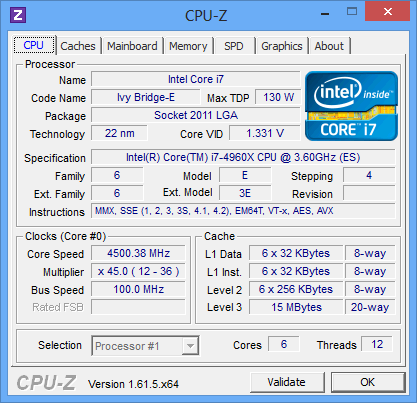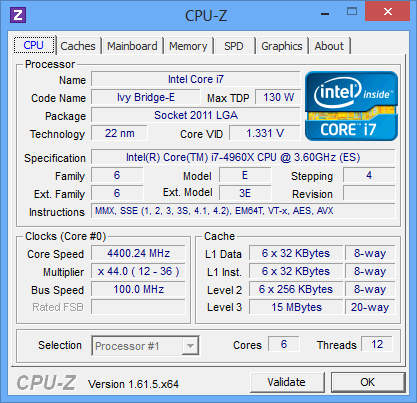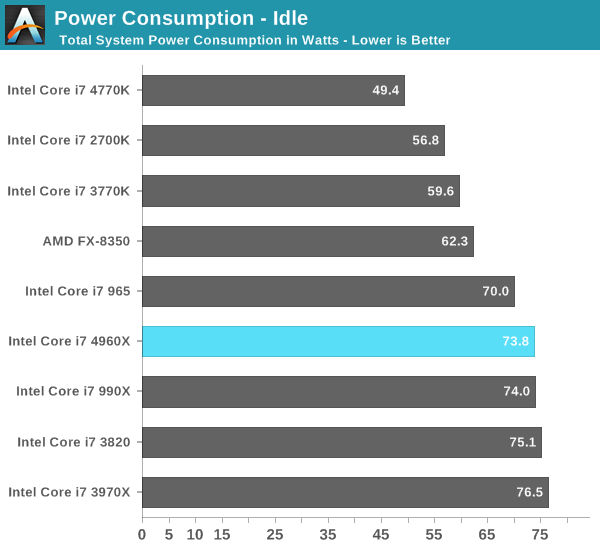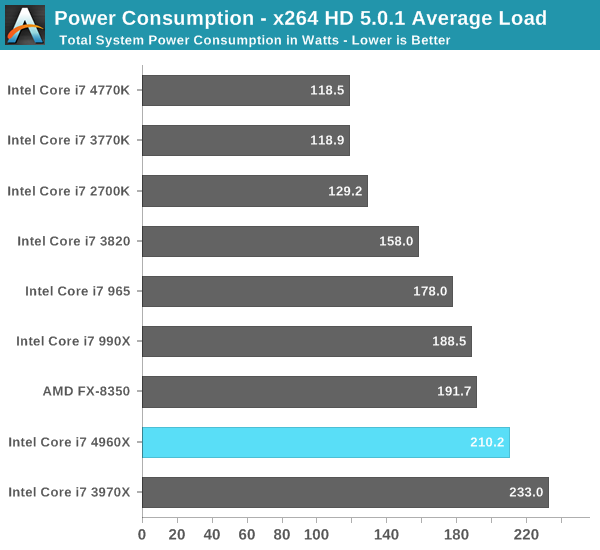Intel Core i7 4960X (Ivy Bridge E) Review
by Anand Lal Shimpi on September 3, 2013 4:10 AM EST- Posted in
- CPUs
- Intel
- Ivy Bridge
- Ivy Bridge-E
Overclocking
As I mentioned earlier, all of the IVB-E launch SKUs ship fully unlocked. Intel offers multipliers up to 63x for you to choose from when overclocking. Like SNB-E before it, IVB-E supports specific BCLK straps (125MHz and 166MHz, in addition to 100MHz) for those overclockers looking to get the absolute most out of their chip. At these overclocked BCLK frequencies, PCIe and other buses are properly divided down so they aren't overclocked (although if you increase the BCLK frequency beyond these strap defaults you will once again be overclocking other buses that derive their frequencies from BCLK). In practice, the cleanest/simplest way to overclock any K-series SKU is by increasing the multiplier.

In our review of the Core i7-3960X I managed a maximum stable overclock of 4.6GHz. I've been told to expect a similar average for Ivy Bridge E. Using Intel's RTS2011LC self contained/closed loop liquid cooling solution I could get into Windows 8 as high as 4.6GHz at 1.42V, however my testbed wasn't stable through all of my tests at that frequency/voltage combination. Moving to higher voltages didn't help, so I had to back down on frequency. I ultimately ended up perfectly stable at 4.3GHz, with 4.4 - 4.5GHz possible with better cooling. The added power needed to hit these frequencies was substantial. I measured a 58W increase in average load power consumption at 4.3GHz/1.4V.

From what I've seen, my sample is a bit on the disappointing side in terms of overclockability. Either way, it doesn't look like you're going to be seeing overclocks significantly higher than what was possible with SNB-E.
Power Consumption
With the 4960X delivering around 5% better performance than the 3970X, the only remaining question is how much more power efficient the move to 22nm made things. Using the same ASUS X79 Deluxe board for both parts, I was able to answer that question.
At idle there's hardly any difference between SNB-E and IVB-E. Under load it looks like IVB-E is good for around a 20W reduction in total system power. It's not an insignificant savings, but definitely not enough to warrant an upgrade if you're on SNB-E already. Anyone looking to migrate to LGA-2011 for the first time will want to go with IVB-E as it is the more thermally efficient solution.












120 Comments
View All Comments
madmilk - Tuesday, September 3, 2013 - link
If you invested in the 980 or the 970 (not the extreme ones) you got an awesome deal. Three years old, $600, overclockable, and within 30% of the 4960X on practically everything.bobbozzo - Tuesday, September 3, 2013 - link
True, but my Haswell i5-4670k was around $200 for the CPU (on sale), and under $150 for an ASUS Z87-Plus motherboard.It's running on air cooling at 4.5/4.5/4.5/4.4GHz.
I wasn't expecting it to be as fast for gaming as an i7-4770k, but looking at the gaming benchmarks in this article, I'm extremely pleased that I did not spend more for the i7.
althaz - Tuesday, September 3, 2013 - link
I had a launch model Core 2 Duo (the E6300) that with overclocking (1.86Ghz => 2.77Ghz) was a pretty decent CPU until last year (when I replaced it with an Ivy Bridge Core i5). That's what? Six years out of the CPU and it's still going strong for my buddy (to whom it now belongs).Kevin G - Tuesday, September 3, 2013 - link
"My biggest complaint about IVB-E isn't that it's bad, it's just that it could be so much more. With a modern chipset, an affordable 6-core variant (and/or a high-end 8-core option) and at least using a current gen architecture, this ultra high-end enthusiast platform could be very compelling."I think that you answered why Intel isn't going this route earlier in the article. Consumers are getting the smaller 6 core Ivy Bridge-E chip. There is also a massive 12 core chip due soon for socket 2011 based servers. Harvesting an 8 core versions from the 12 core die is an expensive proposition and something Intel may not have the volumes for (they're not going to hinder 10 and 12 core capable dies to supply 8 core volumes to consumers). Still, if Intel wanted to, they could release an 8 core Sandy bridge-E chip and use that for their flag ship processor since the architectural differences between Sandy and Ivy Bridge are minor.
The chipset situation just sucks. Intel didn't even have to release a new chipset, they could have released an updated X79 (Z79 perhaps?) that fixed the initial bugs. For example, ship with SAS ports enabled and running at 6 Gbit speeds.
Sabresiberian - Tuesday, September 3, 2013 - link
"The big advantages that IVB-E brings to the table are a ridiculous number of PCIe lanes , a quad-channel memory interface and 2 more cores in its highest end configuration."I'm going to pick on you a little bit here Anand, because I think it is important that we convey an accurate image to Intel about what we as end-users want from the hardware they design. 40 PCIe 3.0 lanes is NOT "ridiculous". In fact, for my purposes I would call it "inadequate". Sure, "my purposes" are running 3 2560x1440 screens @ 120Hz and that isn't the average rig today, but I want to suggest it isn't far off what people are now asking for. We should be encouraging Intel to give us more PCIe connectivity, not implying we have too much already. :)
canthearu - Tuesday, September 3, 2013 - link
Actually, you would find that you are still badly limited by graphics power, rather than limited by system bandwidth.A modern graphics card doesn't even stress out 8 lanes PCIe 3.0.
I'm also not saying that it is a bad thing to have lots of I/O, It isn't. However you do need to know where your bottlenecks are. Otherwise you spend money trying to fix the wrong thing.
The Melon - Tuesday, September 3, 2013 - link
Not all high bandwidth PCI-e cards are graphics cards.I for one would like to be able to run 2x PCIe x16 GPU's and at least 1 each of LSI SAS 2008, dual port DDR or QDR Infiniband, dual port 10GBe and perhaps an actual RAID card.
Sure that is a somewhat extreme example. But you can only run one of the expansion cards plus 2 GPU before you run out of lanes. This is an enthusiast platform after all. Many of us are going to want to do Extreme things with it.
Flunk - Tuesday, September 3, 2013 - link
Now you're just being silly, sending $10,000 on a system without any real increase in performance for anything you're going to do on a desktop/workstation is just stupid.Besides, if you're being incredibly stupid you'd need to go quad Xeons anyway (160 PCI-E lanes FTW).
Azethoth - Tuesday, September 3, 2013 - link
On the one hand, good review. On the other hand, my dream of a new build in the "performance" line is snuffed out. It just seems so lame making all these compromises vs Haswell, and basically things will never get better because the platform target is shifting to mobile and so battery life is key and performance parts will just never be a focus again.f0d - Tuesday, September 3, 2013 - link
i feel the same waythe future doesnt look too bright for the performance enthusiast - i dont want low power smaller cpu's i want BIG 8/12 core cpus and i dont really give a crap about power usage